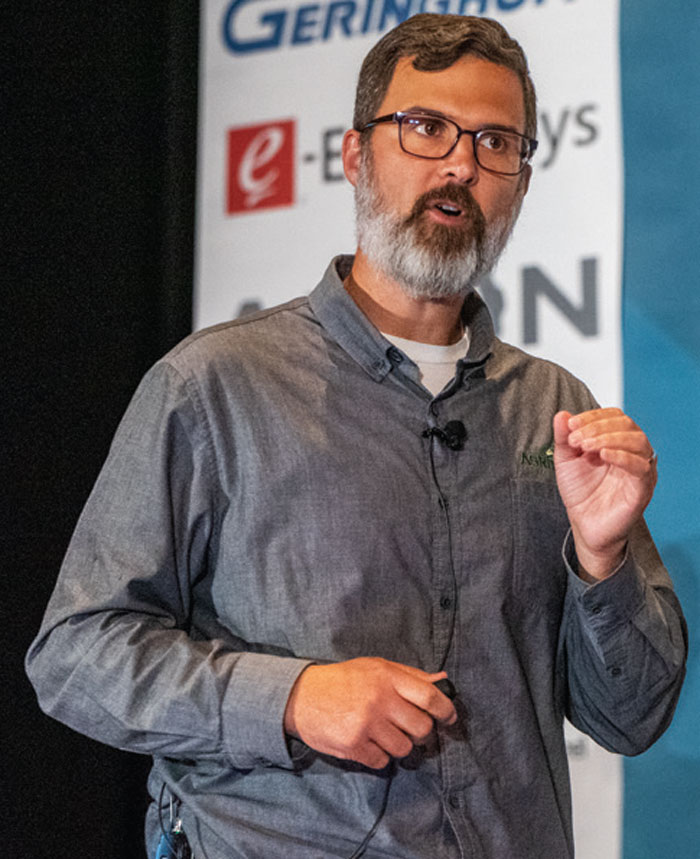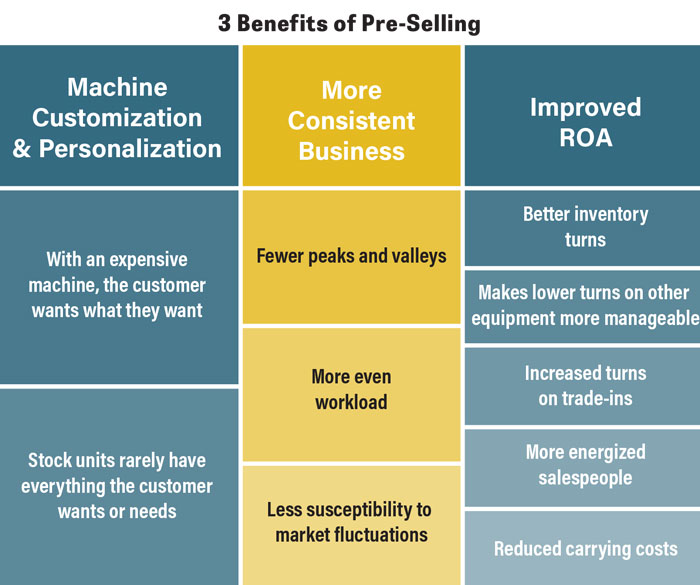By B.J. Knutson, President & COO, Titan Machinery, Fargo, N.D.
Pre-selling ag equipment is not a new concept. Many dealers were forced into pre-selling to some degree during recent equipment inventory shortages and when many manufacturers had been on allocation. It is not, however, something every dealership does, even though most know pre-selling is a healthier way to run their business. That’s because pre-selling requires discipline. Just as most people know that it’s healthier to eat right and exercise, they avoid healthier choices due to a lack of discipline.
Takeaways
- Jump in to pre-selling — don't wait for the "right time."
- Educate customers and salespeople on the benefits.
- Ensure your suppliers are aligned with your plans.
- Take trade-ins on a per-hour or per-acre basis.
It’s healthier for their business because it can help them take better control of their balance sheets. It’s easy to react to OEM requests for wholesale orders and assume that if you stock it, you will sell it. Such an approach, however, is really only beneficial to OEMs in the short term. By comparison, if dealer principals and sales personnel have the discipline to dive in and pre-sell consistently, there can be significant benefits. It allows everyone involved to plan their business better. Customers, for instance, have the opportunity to plan with their accountants and bankers. Equipment manufacturers can do better business planning. Pre-selling is simply a better practice for the ag equipment industry.
Improve Customer Service
The machines customers buy are becoming increasingly expensive. Combines as well as 4WD tractors can have list prices over $1 million. When customers are writing a big check, they want exactly what they want — including all the different options and features that will work for them. Stock units rarely have everything the customer is looking for. You have likely experienced seeing a customer get excited about a particular product only to find there isn’t one on the lot with the options the customer wants.
Yes, you can customize stock units. While putting items on a piece of equipment for a customer, like front or rear PTO or 3-point hitches, is not very difficult, it is not necessarily a good use of shop time. This is especially true given the pervasive technician shortage throughout the industry. Most dealership shops are swamped with work and short on techs. Furthermore, there continue to be parts shortages driven by the supply chain.
“Pre-selling is simply a better practice for the ag equipment industry…”
Shop space is also an issue. Over the last 5 years, labor and materials have caused shop additions to double in cost. It’s not especially feasible to simply add 20,000 square feet, making it critical that dealers effectively use the shop space they have.
Pre-selling allows dealers to plan ahead. They have time to order special parts and add-ons and plan when their service department can tailor the equipment for the customer. Ultimately, dealers will be better able to provide an outstanding customer experience.
Ensure Business Consistency
Ag equipment sales is a cyclical business. Pre-selling can help reduce the peaks and valleys by helping achieve higher highs and higher lows — and a more even workload throughout the year — thanks to the ability to plan more effectively.
A lot of dealership business tends to be weighted toward the fourth quarter with customers waiting to see how the crop is going to be before investing in equipment for next year. This is despite the fact that many customers have balance sheets that are in good shape, and they have every intention of farming tomorrow and next year. They are in a position to write a check or finance a new combine or tractor right away. What they really need is the same thing you need — the ability to plan their business and mitigate uncertainty. Pre-selling equipment allows them to do that while helping you avoid their “wait and see” approach.

B.J. Knutson
With 20-plus years of experience at Dealership of the Year alumnus Titan Machinery — ranging from sales consultant to store and complex manager to president/COO — B.J. Knutson has been leading the pre-selling charge at the 100-plus-location Case IH dealership group. “We took a chapter from what Deere and high-end automotive were doing and started getting our customers geared toward our pre-selling,” he says. Those efforts have paid off in what Knutson says contributed to exceptional sales years in 2022 and 2023 — $2.8 billion over the last 2 years. Because the specs for each piece of equipment are unique to the customer, he says 9 out of 10 times Titan can get the customer the best price through pre-selling.
Photo by: Jeff Lazewski
For example, farmers need some kind of depreciation on their equipment at tax time. With pre-selling, they can plan depreciation with their accountants and ensure they have some level of consistency. You may remember the period from 2010-13 when many customers were doing Section 179 accelerated depreciation. Some actually ran out of depreciation and had to deal with the double whammy of not having depreciation in subsequent years when they weren't making money. If they pre-buy equipment, they can more effectively plan and avoid such situations.
Improve ROA
Pre-selling offers particular benefits when it comes to return on assets, which many consider the most important KPI in the ag equipment industry. With pre-sold equipment, you will enjoy better inventory turns for a number of reasons. You’ll get more visibility with customers and longer lead times to sell the equipment. There will be more time to plan future workloads with the shop, including the machine inspection, ordering any necessary parts, planning the service schedule and — if it hasn’t already been sold — getting it out for sale on the lot.
Your salespeople will be more energized, as well. Every dealer knows how salespeople get when a piece of equipment sits on the lot. They tend to avoid it because it starts to get a negative connotation in their mind. With the fresh inventory that comes from pre-selling, the sales team will have more confidence with customers because things are “turning and burning.”

3 Ways to Be a Pre-Selling Success
By Art Aiello, Managing Editor
Edmund Byne, director of sales for 7-store AGCO dealer Agriteer, offers 3 pieces of advice for dealers to make pre-selling an ongoing success: understand pre-selling lets you offer customers the best deal, help the customer plan for their future needs and communicate effectively when there are issues.
Pre-selling gives dealers a unique opportunity to offer customers the best deal. “Manufacturers offer the best price if you pre-sell equipment,” Byne says. “Why? It's cheaper for them than having it on your lot for a given period of time. It saves them money and interest.” Byne adds that finance rates usually are better, as well.
According to Byne, dealers also have an opportunity to offer their best price because pre-selling can and should apply to trade-ins. “If you have an opportunity to pre-sell that trade-in before it ever hits your lot, you as a dealership have the ability to get a little bit more aggressive on that price.”
Byne notes these pricing considerations aren’t just about making the product more affordable. They’re about adding value for the customer, and he says it’s up to the salesperson to deliver. “It's agriculture — we're in this together. If you want to truly pre-sell equipment, you've got to own that relationship by adding value to his operation. It's not just about being a salesman — it's about being a business partner. Understanding that customer's operation well enough to know how to help him not only get into his next piece of equipment but guide him in the right direction.”
Because pre-buying equipment may be unfamiliar to the customer, Byne says it's crucial to help the customer plan effectively for the upcoming year. This begins with physically visiting the customer.
“If we're trying to add value to the customer, go to his farm and walk around,” Byne says. “This sounds crazy to say, but we have some good salespeople, and sometimes our salespeople have their blinders on, and they just focus on the product they sell.”
Once pre-selling becomes a routine with the customer, Byne recommends conducting an annual needs assessment to help the customer plan. “Are they buying more acres? Are they looking at expanding their operation? Is the current equipment they have hurting their back at the end of the day? Look at all the options. Look at it from all angles — all perspectives. Because you want to come alongside this farmer as a business partner and help them grow.”
Product demonstrations also help the customer plan. “If you're on this farm and you find out there's a product he doesn't have that he wants to try out, it's up to you to find it,” Byne says. “Invest the time and money to get the product to them to try it out.”
Despite the planning and partnership, things can and do go sideways, even in a pre-selling arrangement. Byne points out many ways a dealer can manage through these situations.
“Set clear expectations,” he says. “I guarantee you manufacturers are not trying to hold on to products to prevent you from selling them. They want you to have them. If you believe they're doing the best job they can, you're doing the best job you can. Set that expectation. We're going to do our best knowing that some of these delivery dates are going to fluctuate. Be careful committing to full dates.”
Byne also suggested being careful when it comes to trade-ins, especially if you pre-sell the trade, because the customer’s new equipment might be late and the trade-in won’t be available as planned. “Try to have a plan in place, whether it’s renting them a unit or letting them use a unit that you already have there,” he says. “You have to make sure your used equipment is set up and prepped and ready to go to the field.”
In any event, Byne recommends communicating with customers regularly. “I hate it when we order a piece of equipment, and I don't hear from anybody for 6 months, and then all of a sudden I get a message that says, ‘Oh, by the way, it's going to be 6 more months before you get your product,’” he says. “I don’t enjoy that. I know that our customers also don’t enjoy that. Communicate with them regularly about products, when the delivery dates are.” Byne adds that such communication builds trust with the customer, even if they are frustrated with the message.
Edmund Byne, director of sales for Agriteer, speaks about pre-selling at DMS 2023. Photo by: Jeff Lazewski
If everything goes well, you can turn a particular type of machine as often as once a month — as many as 12 turns per year. However, 6 turns per year is more reasonable, which is still an improved turn rate compared to stock equipment. After all, the 2022 NAEDA Cost of Doing Business study reported average inventory turnover at 3.36. This affords you the ability to take some lower-turn items — such as shortlines you need to stock but are more impulse buys that turn less often — and blend them with the higher-turn, higher-value assets for improved ROA. It also dramatically diminishes equipment aging, or “lot rot,” and the associated write-downs that come with it, further improving ROA.

There are two additional things to note regarding pre-selling and inventory turns. First, it’s not limited to new equipment. Pre-selling can and should be applied to used equipment, as well. It allows you to find a home for the customer’s used equipment before it ever arrives as a trade-in.
Next, pre-selling helps reduce your carrying costs. As dealers cope with 7% or, for many manufacturer lines right now, interest costs as high as 11%, slower turns will mean as much as 5 times the interest paid this year compared to 2022. You can avoid that by pre-selling.
Ensure Long-Term Success
Pre-selling is something any dealer can begin at any time. You shouldn’t be afraid to simply jump in. Everyone has to start somewhere.
To be successful at pre-selling, you will have to educate customers, which can take a while. It’s not what customers initially think they want. As dealers get into pre-selling with them, however, customers will start to see the benefits.
Online Extras
- “Mastering the Art & Science of Pre-Selling,” from the 2023 Dealership Minds Summit. This and all the Summit videos are brought to you courtesy of DeLaval.
- Read Edmund Byne’s case study on how to conduct a product demonstration that sells both your product and your dealership.
At first, they will want the equipment to remain on your balance sheet and expect you to have several different models available — with a variety of options — allowing the customer to show up and buy equipment when it's convenient for them. For that reason, it will be important to educate sales personnel, as well, so that they can effectively deal with customer questions and concerns.
You must also educate suppliers and ensure they are aligned with your dealership so that pre-buying equipment is always the best deal for the customer. It cannot work effectively if an OEM drops prices or adds additional programs on stock units at a later date. It will make it appear as if you are going back on your word that there would be no better time to buy, damaging your reputation with the customer.
“Pre-selling can and should be applied to used equipment, as well. It allows you to find a home for the customer’s used equipment before it ever arrives as a trade-in…”
There are some potential pitfalls with pre-selling to be aware of, specifically when it comes to forecasting the value of the customer’s trade. It’s important to rely on your valuation team to anticipate the future value of your customer’s trade, especially when entering a period of declining used equipment values, such as the one that’s approaching.
The trade unit will typically come in 6 or 9 months from the time you complete the pre-sale deal, so it’s important to know how many hours will be on the unit and what condition it’s going to be in. Set expectations with the customer when you do the inspection and finalize the deal. Make sure to trade on a cost-per-hour and cost-per-acre basis. That way if the trade doesn’t come in on time or the customer puts more hours on the machine, you aren’t locked into a set fixed total amount for the trade.
Over the long term, the key to being successful in pre-selling is having discipline. Be prepared for “stubbing your toe” on some of your first deals. You might even lose a little money early on. Maybe there will be a hiccup on the condition of the trade when it comes in. You’re going to experience that. But don’t give up. Learn from it, assess, refine and do it again.





